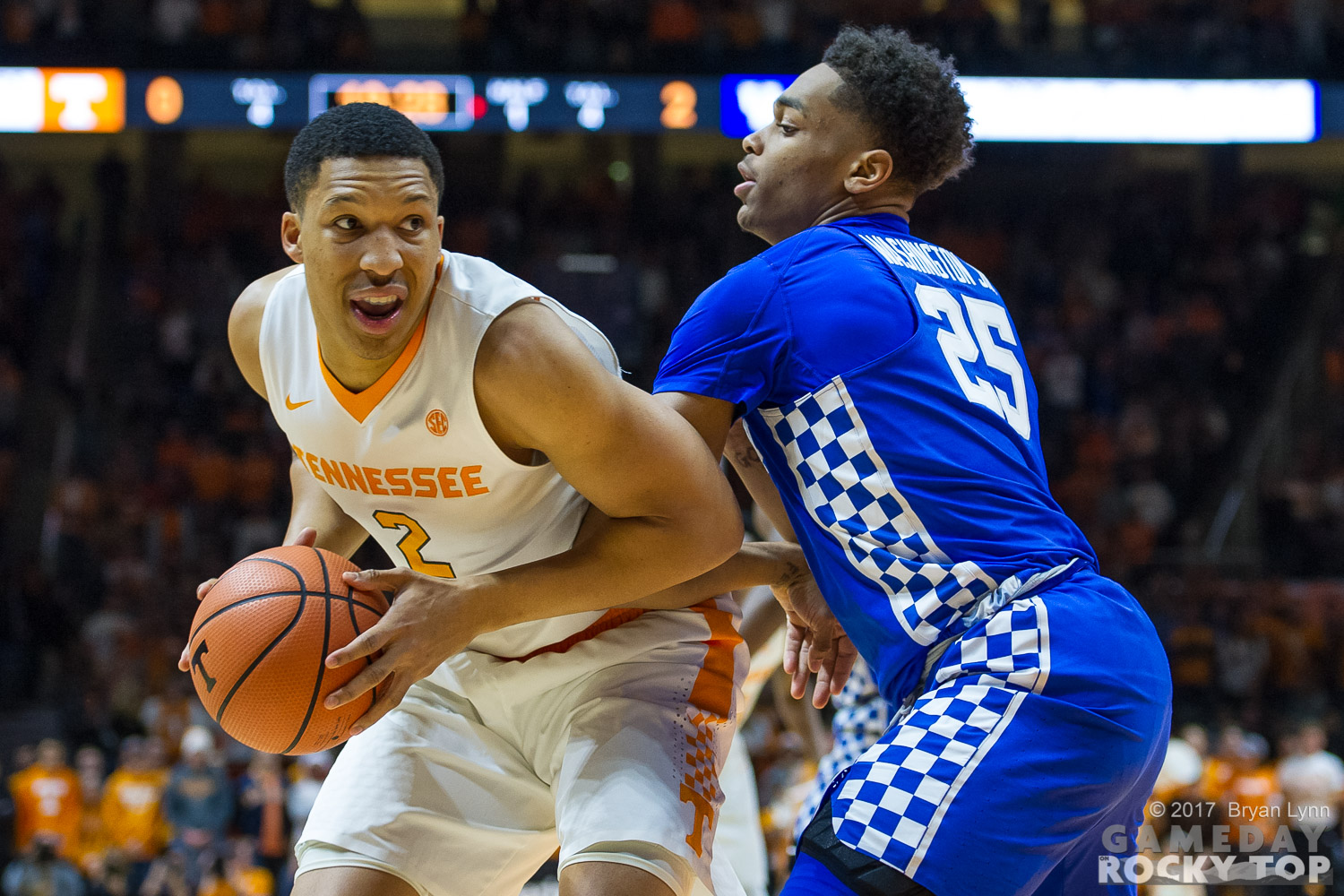We last looked at the NCAA men’s basketball team sheets on February 5. At the time, the Vols were 19-1 overall and No. 4 in the NET Rankings, and we concluded that the machines were becoming a problem for the Vols’ NCAA resume because they didn’t like Tennessee’s defensive numbers.
Here’s how that same table looks now:
| Algorithms | Records | ||||||||||
| NET | KPI | SOR | BPI | POM | SAG | Overall | Q1 | Q2 | Q3 | Q4 | |
| Gonzaga | 1 | 9 | 7 | 1 | 2 | 2 | 27-2 | 4-2 | 7-0 | 5-0 | 11-0 |
| Virginia | 2 | 2 | 1 | 2 | 1 | 3 | 24-2 | 9-2 | 5-0 | 2-0 | 8-0 |
| Duke | 3 | 1 | 2 | 3 | 3 | 1 | 24-3 | 8-2 | 7-1 | 5-0 | 4-0 |
| Houston | 4 | 7 | 10 | 15 | 16 | 18 | 26-1 | 4-1 | 10-0 | 3-0 | 9-0 |
| Kentucky | 5 | 4 | 5 | 6 | 5 | 6 | 23-4 | 9-3 | 5-1 | 4-0 | 5-0 |
| Michigan St. | 6 | 5 | 4 | 4 | 4 | 5 | 23-5 | 11-3 | 3-2 | 5-0 | 4-0 |
| Tennessee | 7 | 15 | 8 | 7 | 9 | 7 | 24-3 | 5-3 | 5-0 | 7-0 | 6-0 |
| UNC | 8 | 6 | 3 | 5 | 6 | 4 | 22-5 | 7-5 | 5-0 | 6-0 | 4-0 |
The KPI hates Tennessee as much as Dan Wolken, and the other computers aren’t especially fond of the Vols, either. And yet, the NET Rankings don’t seem bothered at all that the machines are even less impressed with Houston.
That’s probably a pretty good (and reasonably comforting) indication that even though the NCAA Selection Committee members may lean to some degree on the ancillary information included on the team sheets, the NET Rankings themselves are using their own formulations to rank the teams. Even more importantly, it’s beginning to appear that actual game results are being valued more by the NET Rankings than efficiency numbers, which is also comforting.
If you look at the Records section of the above table, the only reasonable explanation for Houston being at No. 4 is that it’s the only team in the Top 8 to have only one loss. The three teams ahead of Houston all have two Quadrant 1 losses, but two of those three also have at least double Houston’s Quadrant 1
None of the teams in the Top 8 have any Quadrant 3 or 4 losses. Only Duke, Kentucky, and Michigan State have Quadrant 2 losses. Michigan State is the only team with two Quadrant 2 losses (plus they’re are one of four teams in the Top 8 with three or more Quadrant 1 losses), but they also have at least two more Quadrant 1 wins than any other team.
What’s this mean for Tennessee?
Relative to most of the other teams in the Top 8, the primary weakness of Tennessee’s win/loss resume is the number of Quadrant 1 wins. Like the Vols, both Kentucky and Michigan State have 3 Q1 losses, and those two teams also have 1 and 2 Q2 losses, yet are ahead of Tennessee in the rankings. Why? It could be the non-Team Index numbers, sure, but it probably has more to do with the fact that the Vols have only 5 Q1 wins to Kentucky’s 9 and Michigan State’s 11
The good news is that Tennessee is going to have the opportunity to do exactly that. Of their final four opponents of the regular season, all four are Q1 opponents. According to KenPom, the Vols are favored in three of those games, and the final one at Auburn is essentially a toss-up. Win out, and Tennessee’s Q1 resume goes from 5-3 to 9-3 with zero Q2, Q3, or Q4 losses.
While Tennessee has four Q1 opportunities still ahead, the others have only limited opportunities. Gonzaga and Houston each have only one Q1 opponent left, and Virginia, Duke, Kentucky, Michigan State, and North Carolina each have two. The game between Tennessee and Kentucky at Thompson-Boling this Saturday is huge.
What about Gonzaga?
The fact that Gonzaga is No. 1 with an extremely similar record to No. 4 Houston should tip us off that the computers do still matter when trying to distinguish between similar teams.
The takeaway from that is that it’s still important for the Vols to improve their defensive efficiency, not only because doing so will increase the odds of them posting those all-important Q1 wins, but because doing so would make them more attractive to the computers and the efficiency calculation used by the NET Rankings.
